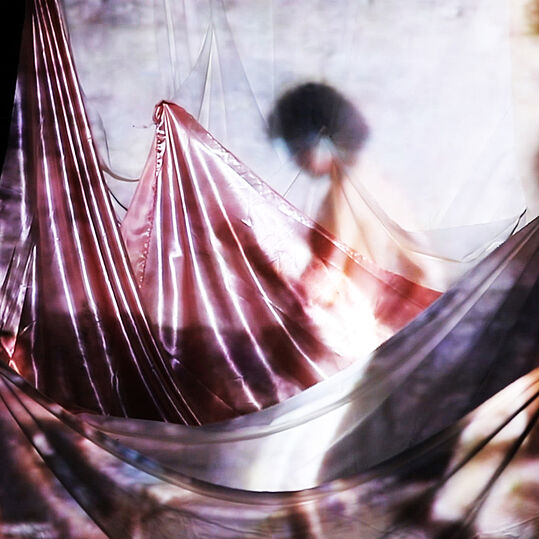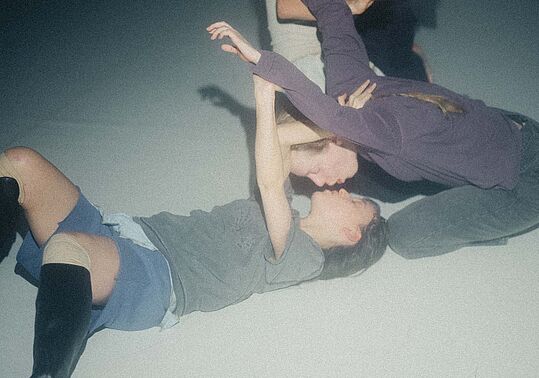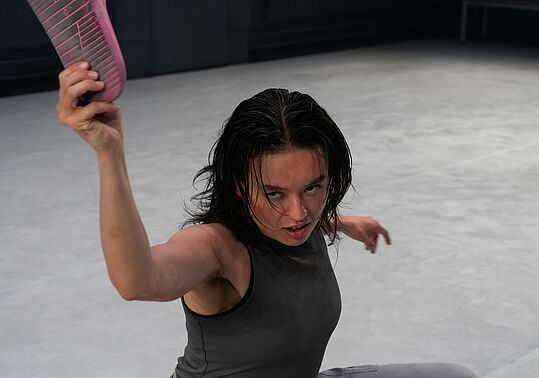A journey
You call your performance Wormhole Stories a multimedia performance. What can we expect?
Maggessi/Morusiewicz: In this performance, we invite the audience into a journey through space, time, sound, image, and storytelling. This is probably why we thought that the category of “multimedia” would fit it best on a descriptive level. While within this project, differently from our other works, we engage more with the performative aspect through our bodily presence on stage, we still try to tackle each medium by itself, creating, or rather, opening a different room/world through each sound, story, and projected image that we share.
Why have you decided to call your project Wormhole Stories?
Maggessi/Morusiewicz: We started collectively thinking about sci-fi wormholes around 2 years ago, while developing a few projects and applying for funding. The word “wormhole” can refer to many things. It can be a hole in fruit burrowed by an insect. It can be a portal through which you travel in space and time in a matter of seconds - this is how they are used in literature and film. “Wormhole” can also describe the process of doing preliminary research, where you jump from hyperlink to hyperlink, from one Wikipedia article to another. What particularly interests us about wormholes is the temporal space that they occupy. How does time feel when you are in a wormhole? What is it like to linger in a wormhole? What happens if you extend the time of remaining in a wormhole on the way to being ejected on its other end?
When working on this project, we searched for wormholes in different places: in films but not necessarily sci-fi, as well as in our surrounding. We started noticing that many stories that we watch, read, or hear have wormhole-like moments, also because of the way they are told. For instance, in one road movie, the characters start a conversation while getting into a car and then continue it, without a break, after a cut, when they get out of the car. While we hear the whole conversation, we don’t see their trip. We thought of the moments that were edited out: what did they talk about when they were in the car? Did they drive in silence, as if waiting for the camera to start filming them again? What happened in the meantime? We also noticed a wormhole quality in the pre-AIDS artistic gay pornographic films, seemingly more interested in plots and images that are not directly about sex. A common trope in gay (and not only) porn would be someone knocking on the door: a delivery guy bringing pizza, a next-door neighbor asking for help, a plumber brought to fix leaking pipes. This would be a narrative gimmick necessary for the characters to start having sex. But what happened to the pizza? Did the neighbor ever receive the help? Did the pipes get eventually repaired? The pre-AIDS gay-porn films seemed to be willing to explore the meantime, i.e. the time that the characters would spend between having sex.
Such moments made us think of our wormholes, of this feeling that you have when some moments seem to go much faster or slower than others, while, in fact, taking the same amount of time. These would be moments of emotional and sexual encounters, when a person that you are in bed with for the first time takes off their Tshirt, or when you walk, slightly tipsy, from a bar to someone’s place to spend the night together. Wormhole Stories is for us an effort of staying with fleeting moments and narrative gaps within the multiple stories that we have gleaned and brought into this project.
You both work together as a duo since 2020. How would you describe your collaboration?
Maggessi/Morusiewicz: Our collaboration is based on common interests, desires, and struggles. We started working together at the moment when each of us was quite overwhelmed with pursuing a career in artistic research/practice, while working several other jobs on the side: Gui is also an art director and designer, and Rafal has had a teaching practice. What interested us was to find a way to converge all our working experience into the artistic practice, and to do this in collaboration. Our aim has been to imagine and create a sustainable practice and foster it within our network of colleagues, friends, and families.
Our collective practice is conceptual. It is informed by multiple theoretical concepts, historical events, and pop-cultural references. What we find important is the simultaneity between creating new narratives and contaminating the old ones. Our work is constantly sustained by ambivalence and contradiction. We are interested in materiality and medium. In every work that we do, we try to make as many things by ourselves as possible: a soundtrack or a projection screen. We are also interested in continuity and repetition between projects, which also means re-using and remixing footage, set design elements, music, and themes. An example of that is our performance, which belongs to a broader scope of projects, including an exhibition and a film work.
In summary, our collaboration is oriented towards the lack of “final” completion. It constantly keeps going.
It was possible for you to work on your project as part of HUGGY BEARS. How was the mentoring program for you?
Maggessi/Morusiewicz: The mentoring program was extremely helpful in a number of ways. As both of us come from the fine- and applied-arts backgrounds, we had the chance to dedicate more space and time to developing our practice in a more performative manner. We had the privilege of practice and rehearsal time in the studios at Bears in the Park, a space that is a gem in Vienna’s art scene. As a group of three productions, we were lucky to vibe nicely with each other and have similarly-yet-completely different interests within our works. The feedback sessions in the group, along with Philippe and Charlotte, were extremely helpful in order to try things out and see how and if certain ideas work. HUGGY BEARS is great at connecting its mentees with the local scene. We were offered a chance, for example, to show an early work-in-progress version of our piece during the imagetanz festival with brut Wien (format ”Handle With Care”). Also, during the Impulstanz festival, we were also able to take part, free of charge, in a few workshops that taught us a lot and greatly informed our practice. All in all, this year has brought a few exciting developments to our practice and visibility as artists, to a large extent thanks to HUGGY BEARS. We are very grateful.







